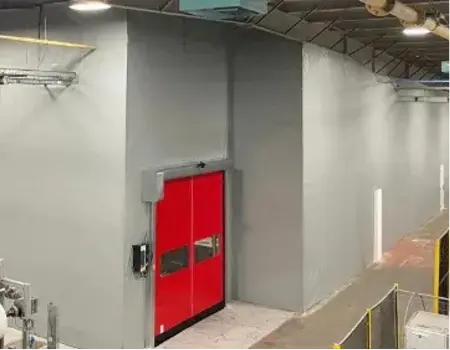The Costs of Dust Contamination and How Industrial Partition Curtains Prevent It
By Luke Hutchinson on Nov 10, 2025 9:58:54 AM

Dust might seem like an unavoidable part of any busy production floor. But when it settles into machinery, drifts into clean areas or contaminates finished products, it becomes a serious and expensive problem.
From fine metal shavings in automotive plants to flour dust in food production facilities, contamination spreads easily across open-plan sites, affecting quality, complicating compliance and quietly eroding profits and productivity.
Understanding the real cost of dust contamination, and how to prevent it with industrial partitions or workshop curtains, can make a measurable difference to the efficiency and safety of your facility.
The Hidden Costs of Dust Contamination
Dust isn't just unsightly. It carries measurable financial and operational implications that directly affect your bottom line.
Even small accumulations can clog filters, jam sensors and wear down moving components, leading to unplanned shutdowns and expensive repairs. Airborne particles act like abrasive grit on precision machinery, shortening component life and forcing premature replacements. In facilities using sensitive equipment, this wear can occur surprisingly quickly.
Contamination during assembly or finishing stages can result in entire product batches being rejected, wasting materials, time and labour. The presence of dust also drives up cleaning and maintenance requirements, diverting staff from production and adding costs for chemicals, labour and waste disposal.
For medium to large manufacturing facilities, these costs can accumulate to tens or hundreds of thousands of pounds annually. This is an expense many operators underestimate until performance issues or audit failures force action.
Health and Safety Implications
Beyond production impacts, dust poses significant compliance and workforce risks.
The Health and Safety Executive (HSE) enforces strict regulations around airborne particulates under EH40 Workplace Exposure Limits. Inhalable and respirable dusts can cause long-term respiratory damage, skin irritation or occupational asthma. Even seemingly innocuous substances like flour or icing sugar pose risks when inhaled regularly over time.
Failing to control exposure invites enforcement action, increased sick leave and reputational damage. Implementing effective dust containment not only supports HSE compliance but demonstrates a proactive approach to workforce welfare. This is something that increasingly influences supplier approval and audit outcomes.
Cross-Contamination in Food and Clean-Zone Applications
For food manufacturers and clean-zone operations, airborne particles represent a critical hygiene risk.
Flour dust, allergens and fine residues migrate easily through open spaces, jeopardising product safety and causing cross-contamination between production lines. This is particularly problematic in facilities handling multiple allergens or operating under BRCGS and HACCP standards.
The financial and reputational consequences of a product recall far outweigh the cost of prevention, making physical separation between production zones essential rather than optional.
How Dust Migrates in Open-Plan Facilities
Dust migration occurs through airflow, foot traffic and the movement of materials and vehicles. Once airborne, particles follow air pressure differences created by ventilation systems, machinery heat or open doors, travelling well beyond their point of origin.
In automotive manufacturing, for example, welding and grinding operations generate fine metallic particles that can drift across the facility, settling on assembly areas and finished components. In food production, similar patterns occur with organic dusts and processing residues.
Without physical barriers, these particles settle across production zones, packaging areas and finished goods storage, creating long-term contamination challenges that undermine quality control and increase operational costs.
Why Industrial Partition Curtains Are a Smart Solution
Given the complexity of dust migration, effective containment requires a solution that's both comprehensive and adaptable.
Unlike traditional solid walls, industrial partition curtains provide a flexible, cost-effective alternative for containing dust. They can be installed quickly without major structural changes, allowing production to continue with minimal disruption. Curtains can be repositioned or extended as operations evolve. This makes them ideal for facilities where layouts change frequently or seasonal production demands vary.
Constructed from heavy-duty PVC or reinforced fabrics, these partitions form an effective seal that limits particle spread, helping maintain clean-zone integrity and protect valuable equipment. Their transparency also preserves visibility and natural light transfer, promoting a safer and more efficient workspace.
For businesses handling allergen-sensitive operations, like food manufacturers, partition curtains offer rapid deployment of hygiene-controlled zones without the extended downtime associated with permanent construction. This flexibility proved particularly valuable for clients like Harrison Spinks, who needed to contain soap residue and dust following process changes, and ADE Power, who required a large-scale spray booth solution without the prohibitive cost of permanent structures.
Take Action Against Dust Contamination
Controlling dust contamination goes beyond good housekeeping. It's essential for protecting operational performance, ensuring compliance and safeguarding your bottom line.
By investing in flexible industrial partition curtains, you can reduce maintenance costs, extend equipment life and ensure a cleaner, safer environment for both your people and products. Contact us today to discuss how partition curtains can improve safety and productivity in your facility.
Subscribe by email
You May Also Like
These Related Stories
.webp)
Case Study: Building A Cost-Effective Spray Booth For ADE Power

Case Study: Preventing Cross Contamination And Building A Safer More Flexible Workspace For Harrison Spinks

.png?width=240&height=72&name=Untitled%20design%20(22).png)




No Comments Yet
Let us know what you think